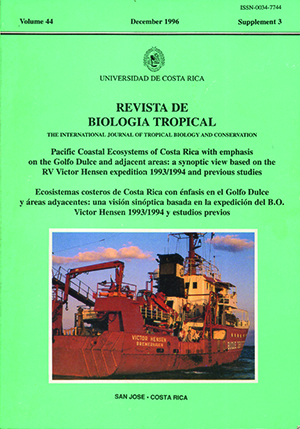Resumen
Golfo Dulce es un estuario tropical profundo y su ecosistema es poco conocido. Para evaluar la distribución de biomasa, flujo de energía, potencial reproductivo, asi como obtener gufas para su administraci6n y conservación, se elaboró un modelo "de estado estable" de 20 compartimemos (excluyendo detritus) con el program a ECOPATH II. La biomasa total del sistema (10.4 t/m2) y el flujo total de energía (suma de todos los flujos, T = 1405 t/km2/año) son pequeños en comparación con otros ecosistemas costeros para los que existen modelos equivalentes. El mayor paso energético es de los niveles tróficos primanamente pelagicos I a II (52%) mas II a III (41%). La biomasa de peces pelagicos consumida por los depredadores mayores (aproximadamenle 1133t) sobrepasa el doble de la biomasa de peces demersales consumidos (502t). La pesqueria artesanal afecta principalmente los niveles tróficos superiores del grupo bentónico y tiene una baja eficiencia bruta (captura/producción primaria = O.06%), Una proporción casi balanceada de producción/respiración (P/R = 1.09) y una alta tasa media de eficiencia de transferencia (15%) sugieren que el sistema se aeerea a su madurez. pero no coinciden con ello la baja "Ascendencia" (A=32.2%) y la alta Capacidad de desarrollo (DC=67.5) calculados por analisis de la red, que por su parte sugieren un sistema relativamente subdesarrollado, con poca estabilidad interna (Baird & Ulanowicz 1993). Este modelo revela que el Golfo Dulce funciona de una manera diferente a la de 18 mayoría de los ecosistemas costeros tropicales: esta dominada por el flujo de biomasa y energía dentro del grupo pelagico y se asemeja más a un sistema oceanico abierto que a uno estuarino. Debido a su baja biomasa béntica y baja productividad general. no parece haber potencial para un desarrollo ulterior de la pesquena demersal y semidemersal dentro del golfo. Un aumento de la presión de pesca pelagica amenazaria gravemente las poblaciones de depredadores residentes como delfines. tiburones y aves grandes. que tienen considerable importancia en conservación y ecoturismo. La investigación futura del ecosistema de este golfo debería concentrarse en la parte pelagica ("lazo" microbinano, plancton y necton). el bentos pequeño. los procesos de transferencia dentro de la sección pelagica, entre la pelágica y el bentos y en las interfases río-golfo y golfo-oceano.##plugins.facebook.comentarios##

Esta obra está bajo una licencia internacional Creative Commons Atribución 4.0.
Derechos de autor 1996 Revista de Biología Tropical
Descargas
Los datos de descargas todavía no están disponibles.


